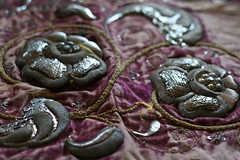
This colored photograph of a lost Leonardo painting was released just recently, and reveals the detail that made it a true work of Leonardo Da Vinci: the glass orb.
The iconography of Christ as Saviour of the World [the Spanish Salvador del Mundo] in the Philippines is rather different and is limited to the Christ Child [Santo Nino] images with both arms outstretched and held high. While the are other Christ Child images holding orbs, they are most often a full regalia with cape, crown, and scepter. And most adult images of the Lord Jesus Christ in the archipelago are populated by the Crucified Christ, the Sacred Heart, Santo Entierro [Christ Interred], and images of his passion and resurrection. Even the enthroned Christ the King is a different iconography altogether.
Examining this fine specimen of art closely, one is immediately drawn to the distant yet faded visage of Jesus Christ, a quality it shares with another Leonardo painting, The Last Supper. It feels eerie to behold at first, but the actual symbolism of a not quite flesh and blood Christ can be viewed as Leonardo's interpretation of the man and God qualities of the savior: that while he is of mortal form, he is not just of any mortal form. His eyes gaze at you but is withdrawn and distant, a quality that modern iconography seems to have forgot by making images of the divine stare back at you as if it was their duty to make that connection. Yet even with that elusive gaze, the hand poised in the traditional blessing looks more solid and heavy. Perhaps the intent was that the blessing does indeed reach us.
The curls on the hair remind us of another Leonardo, and also, what is said to be his final completed oil painting: John the Baptist. To which I bravely engage you to draw parallels with the his use of of the technique called Sfumato. Which by no less dramatic words is this luminous quality the subject emanates while he appears to emerge from this obscure darkness.
Blue, a color often associated with heaven, softens this painting following the folds of the fabric of Christ's robe and provides an almost liquid base albeit color to the glass orb.
While most religious paintings that make use of an orb usually have them in opaque blue, Leonardo cleverly uses the blue of the robes to reveal his glass orb. Only Leonardo's genius could have produced this effect of translucence on a flat surface, with complete consideration for the behavior of light. This is perhaps the proof of Leonardo's experimentation with light, proving his mastery of it, hurdling the difficulties of painting a glass orb whilst revealing what is to be seen beyond it.
The painting is currently valued at 120 million pounds, a far far cry from the 45 pounds spent to buy it decades ago. It was regarded to have been lost, passing into the shadows of the centuries after its documented owner King Charles I of England was executed. The painting shall be exhibited at the National Gallery in London as part of its Leonardo retrospective later this year.
thus spake the Barefoot Baklesa
















No comments:
Post a Comment